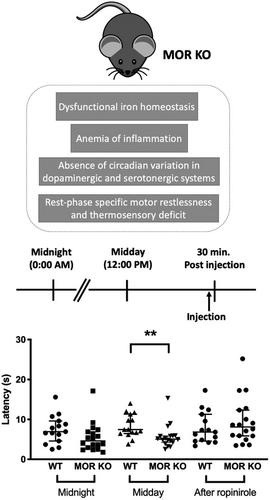当前位置:
X-MOL 学术
›
J. Neurosci. Res.
›
论文详情
Our official English website, www.x-mol.net, welcomes your
feedback! (Note: you will need to create a separate account there.)
Mu opioid receptor knockout mouse: Phenotypes with implications on restless legs syndrome.
Journal of Neuroscience Research ( IF 2.9 ) Pub Date : 2020-05-19 , DOI: 10.1002/jnr.24637 Shangru Lyu 1 , Mark P DeAndrade 1 , Erica L Unger 2 , Stefan Mueller 3 , Alexander Oksche 4, 5 , Arthur S Walters 6 , Yuqing Li 1
Journal of Neuroscience Research ( IF 2.9 ) Pub Date : 2020-05-19 , DOI: 10.1002/jnr.24637 Shangru Lyu 1 , Mark P DeAndrade 1 , Erica L Unger 2 , Stefan Mueller 3 , Alexander Oksche 4, 5 , Arthur S Walters 6 , Yuqing Li 1
Affiliation

|
Restless legs syndrome (RLS) is characterized by an irresistible need to move the legs while sitting or lying at night with insomnia as a frequent consequence. Human RLS has been associated with abnormalities in the endogenous opioid system, the dopaminergic system, the iron regulatory system, anemia, and inflammatory and auto‐immune disorders. Our previous work indicates that mice lacking all three subtypes of opioid receptors have a phenotype similar to that of human RLS. To study the roles of each opioid receptor subtype in RLS, we first used mu opioid receptor knockout (MOR KO) mice based on our earlier studies using postmortem brain and cell culture. The KO mice showed decreased hemoglobin, hematocrit, and red blood cells (RBCs), with an appearance of microcytic RBCs indicating anemia. Together with decreased serum iron and transferrin, but increased ferritin levels, the anemia is similar to that seen with chronic inflammation in humans. A decreased serum iron level was also observed in the wildtype mice treated with an MOR antagonist. Iron was increased in the liver and spleen of the KO mice. Normal circadian variations in the dopaminergic and serotoninergic systems were absent in the KO mice. The KO mice showed hyperactivity and increased thermal sensitivity in wakefulness primarily during what would normally be the sleep phase similar to that seen in human RLS. Deficits in endogenous opioid system transmission could predispose to anemia of inflammation and loss of circadian variations in dopaminergic or serotonergic systems, thereby contributing to an RLS‐like phenotype.
中文翻译:

Mu 阿片受体敲除小鼠:对不宁腿综合征有影响的表型。
不宁腿综合征 (RLS) 的特征是在晚上坐着或躺着时不可抗拒地需要移动腿,经常失眠。人类 RLS 与内源性阿片系统、多巴胺能系统、铁调节系统、贫血以及炎症和自身免疫性疾病的异常有关。我们之前的工作表明,缺乏所有三种阿片受体亚型的小鼠具有与人类 RLS 相似的表型。为了研究每个阿片受体亚型在 RLS 中的作用,我们首先使用 mu 阿片受体敲除 (MOR KO) 小鼠,这是基于我们使用死后脑和细胞培养的早期研究。KO 小鼠显示血红蛋白、血细胞比容和红细胞 (RBC) 降低,小细胞红细胞的出现表明贫血。连同降低的血清铁和转铁蛋白,但铁蛋白水平升高,贫血与人类慢性炎症相似。在用 MOR 拮抗剂治疗的野生型小鼠中也观察到血清铁水平降低。KO小鼠肝脏和脾脏中的铁含量增加。在 KO 小鼠中不存在多巴胺能和血清素能系统的正常昼夜节律变化。KO 小鼠在清醒时表现出多动和增加的热敏感性,主要是在通常与人类 RLS 相似的睡眠阶段。内源性阿片类药物系统传输缺陷可能导致炎症性贫血和多巴胺能或血清素能系统昼夜节律变化的丧失,从而导致 RLS 样表型。在用 MOR 拮抗剂治疗的野生型小鼠中也观察到血清铁水平降低。KO小鼠肝脏和脾脏中的铁含量增加。在 KO 小鼠中不存在多巴胺能和血清素能系统的正常昼夜节律变化。KO 小鼠在清醒时表现出多动和增加的热敏感性,主要是在通常与人类 RLS 相似的睡眠阶段。内源性阿片类药物系统传输缺陷可能导致炎症性贫血和多巴胺能或血清素能系统昼夜节律变化的丧失,从而导致 RLS 样表型。在用 MOR 拮抗剂治疗的野生型小鼠中也观察到血清铁水平降低。KO小鼠肝脏和脾脏中的铁含量增加。在 KO 小鼠中不存在多巴胺能和血清素能系统的正常昼夜节律变化。KO 小鼠在清醒时表现出多动和增加的热敏感性,主要是在通常与人类 RLS 相似的睡眠阶段。内源性阿片类药物系统传输缺陷可能导致炎症性贫血和多巴胺能或血清素能系统昼夜节律变化的丧失,从而导致 RLS 样表型。在 KO 小鼠中不存在多巴胺能和血清素能系统的正常昼夜节律变化。KO 小鼠在清醒时表现出多动和增加的热敏感性,主要是在通常与人类 RLS 相似的睡眠阶段。内源性阿片类药物系统传输缺陷可能导致炎症性贫血和多巴胺能或血清素能系统昼夜节律变化的丧失,从而导致 RLS 样表型。在 KO 小鼠中不存在多巴胺能和血清素能系统的正常昼夜节律变化。KO 小鼠在清醒时表现出多动和增加的热敏感性,主要是在通常与人类 RLS 相似的睡眠阶段。内源性阿片系统传输的缺陷可能导致炎症性贫血和多巴胺能或血清素能系统昼夜节律变化的丧失,从而导致 RLS 样表型。
更新日期:2020-06-25
中文翻译:

Mu 阿片受体敲除小鼠:对不宁腿综合征有影响的表型。
不宁腿综合征 (RLS) 的特征是在晚上坐着或躺着时不可抗拒地需要移动腿,经常失眠。人类 RLS 与内源性阿片系统、多巴胺能系统、铁调节系统、贫血以及炎症和自身免疫性疾病的异常有关。我们之前的工作表明,缺乏所有三种阿片受体亚型的小鼠具有与人类 RLS 相似的表型。为了研究每个阿片受体亚型在 RLS 中的作用,我们首先使用 mu 阿片受体敲除 (MOR KO) 小鼠,这是基于我们使用死后脑和细胞培养的早期研究。KO 小鼠显示血红蛋白、血细胞比容和红细胞 (RBC) 降低,小细胞红细胞的出现表明贫血。连同降低的血清铁和转铁蛋白,但铁蛋白水平升高,贫血与人类慢性炎症相似。在用 MOR 拮抗剂治疗的野生型小鼠中也观察到血清铁水平降低。KO小鼠肝脏和脾脏中的铁含量增加。在 KO 小鼠中不存在多巴胺能和血清素能系统的正常昼夜节律变化。KO 小鼠在清醒时表现出多动和增加的热敏感性,主要是在通常与人类 RLS 相似的睡眠阶段。内源性阿片类药物系统传输缺陷可能导致炎症性贫血和多巴胺能或血清素能系统昼夜节律变化的丧失,从而导致 RLS 样表型。在用 MOR 拮抗剂治疗的野生型小鼠中也观察到血清铁水平降低。KO小鼠肝脏和脾脏中的铁含量增加。在 KO 小鼠中不存在多巴胺能和血清素能系统的正常昼夜节律变化。KO 小鼠在清醒时表现出多动和增加的热敏感性,主要是在通常与人类 RLS 相似的睡眠阶段。内源性阿片类药物系统传输缺陷可能导致炎症性贫血和多巴胺能或血清素能系统昼夜节律变化的丧失,从而导致 RLS 样表型。在用 MOR 拮抗剂治疗的野生型小鼠中也观察到血清铁水平降低。KO小鼠肝脏和脾脏中的铁含量增加。在 KO 小鼠中不存在多巴胺能和血清素能系统的正常昼夜节律变化。KO 小鼠在清醒时表现出多动和增加的热敏感性,主要是在通常与人类 RLS 相似的睡眠阶段。内源性阿片类药物系统传输缺陷可能导致炎症性贫血和多巴胺能或血清素能系统昼夜节律变化的丧失,从而导致 RLS 样表型。在 KO 小鼠中不存在多巴胺能和血清素能系统的正常昼夜节律变化。KO 小鼠在清醒时表现出多动和增加的热敏感性,主要是在通常与人类 RLS 相似的睡眠阶段。内源性阿片类药物系统传输缺陷可能导致炎症性贫血和多巴胺能或血清素能系统昼夜节律变化的丧失,从而导致 RLS 样表型。在 KO 小鼠中不存在多巴胺能和血清素能系统的正常昼夜节律变化。KO 小鼠在清醒时表现出多动和增加的热敏感性,主要是在通常与人类 RLS 相似的睡眠阶段。内源性阿片系统传输的缺陷可能导致炎症性贫血和多巴胺能或血清素能系统昼夜节律变化的丧失,从而导致 RLS 样表型。











































 京公网安备 11010802027423号
京公网安备 11010802027423号